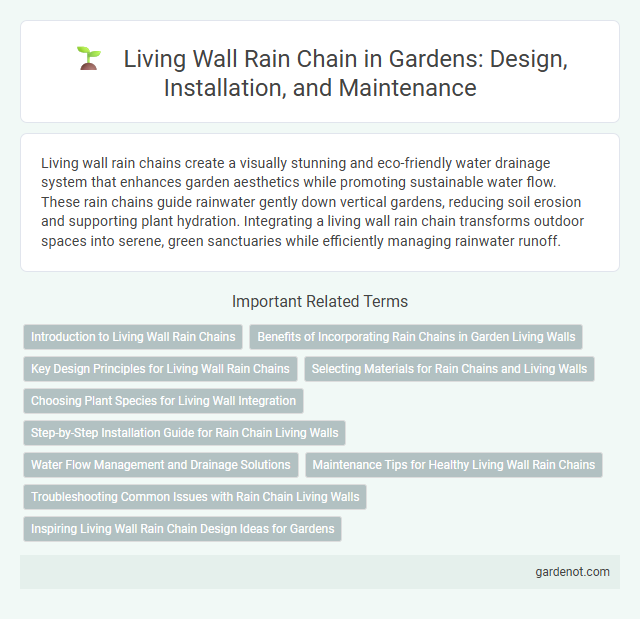Living wall rain chains create a visually stunning and eco-friendly water drainage system that enhances garden aesthetics while promoting sustainable water flow. These rain chains guide rainwater gently down vertical gardens, reducing soil erosion and supporting plant hydration. Integrating a living wall rain chain transforms outdoor spaces into serene, green sanctuaries while efficiently managing rainwater runoff.
Introduction to Living Wall Rain Chains
Living wall rain chains combine vertical gardening with effective rainwater management, directing water flow visibly along a chain structure that supports plant growth. These systems enhance aesthetic appeal while promoting sustainable water usage by capturing and distributing rainwater to lush, living walls. Integrating living wall rain chains improves outdoor spaces by blending natural irrigation with decorative elements, creating eco-friendly, visually striking environments.
Benefits of Incorporating Rain Chains in Garden Living Walls
Incorporating rain chains into garden living walls enhances water management by directing rainfall efficiently along the vertical surface, reducing soil erosion and promoting healthy plant growth. These rain chains create visually appealing water features that add a soothing sensory experience while supporting sustainable irrigation practices. Optimizing moisture distribution helps maintain vibrant, thriving vegetation, improving the overall ecosystem of garden living walls.
Key Design Principles for Living Wall Rain Chains
Living wall rain chains integrate water flow and vertical greenery by emphasizing key design principles such as efficient water distribution, aesthetic harmony with plant placement, and durability of materials exposed to constant moisture. Optimizing structural support ensures the rain chain can bear the combined weight of plants and water, while selecting corrosion-resistant metals like copper or stainless steel prolongs lifespan. Proper spacing and orientation enhance both irrigation effectiveness and visual appeal, creating a sustainable and functional rainwater management system.
Selecting Materials for Rain Chains and Living Walls
Choosing durable, weather-resistant materials such as copper, stainless steel, or galvanized iron ensures longevity and aesthetic appeal for rain chains integrated into living walls. Copper's natural patina complements the greenery of living walls while providing excellent corrosion resistance, making it a popular choice. Incorporating materials that support plant health, such as non-toxic, rust-free metals, helps maintain the vitality of living walls and enhances water flow efficiency.
Choosing Plant Species for Living Wall Integration
Selecting plant species for a living wall rain chain requires focusing on moisture-loving varieties such as ferns, mosses, and succulents that thrive in consistent water flow environments. Incorporate drought-tolerant plants like sedum and ornamental grasses to balance hydration levels and prevent over-saturation. Prioritize native species compatible with the local climate to enhance sustainability and reduce maintenance needs.
Step-by-Step Installation Guide for Rain Chain Living Walls
Installing a rain chain living wall requires securely attaching the rain chain to a gutter downspout or roof edge, ensuring proper water flow direction toward the living wall's irrigation system. Step-by-step, begin by measuring and cutting the rain chain to the desired length, then use hooks or mounting brackets to fix it in place, making sure the chain aligns with the water catchment area. Finish by integrating the rain chain with a water distribution system that nourishes the plants on the living wall, optimizing both aesthetic appeal and sustainable water management.
Water Flow Management and Drainage Solutions
Living wall rain chains enhance water flow management by guiding rainwater efficiently down vertical gardens, preventing soil erosion and water pooling. These systems integrate natural drainage solutions that channel excess water away from plant roots, maintaining optimal moisture levels for healthy vegetation. Rain chains also reduce pressure on traditional drainage infrastructure by promoting controlled water dispersion along the green wall surface.
Maintenance Tips for Healthy Living Wall Rain Chains
Regularly inspect and clean your living wall rain chain to prevent algae buildup and blockages that can disrupt water flow. Use a soft brush and mild soap solution to gently remove debris without damaging plant roots or the chain material. Ensure proper drainage by checking the water catchment system frequently to maintain optimal moisture for both the plants and rain chain functionality.
Troubleshooting Common Issues with Rain Chain Living Walls
Rain chain living walls may experience common issues such as water overflow, uneven water distribution, and clogging due to debris buildup. Regular maintenance involves clearing leaves and sediment from the chain links and ensuring the water flow rate matches the wall's design capacity to prevent damage or plant stress. Adjusting the chain length or adding water diverters can improve water flow consistency and promote healthy plant growth on the vertical garden.
Inspiring Living Wall Rain Chain Design Ideas for Gardens
Living wall rain chains transform vertical garden spaces by seamlessly combining functionality with natural aesthetics, creating stunning water features that nourish plants while enhancing visual appeal. Innovative designs incorporate tiered cups, botanical motifs, and integrated LED lighting to highlight foliage and provide soothing water sounds, promoting a tranquil garden atmosphere. These inspiring elements maximize space efficiency and water recycling, making living wall rain chains an eco-friendly solution for modern garden landscapes.
Living wall rain chain Infographic

 gardenot.com
gardenot.com